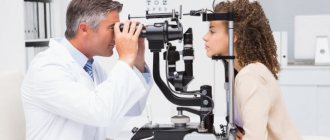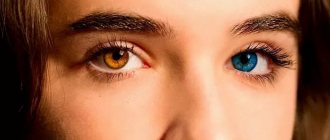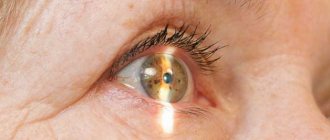Vision is of great importance for knowing ourselves and the world around us. We receive up to 90% of information through our eyes. Therefore, each person needs to monitor the normal functioning of the visual system by regularly visiting the right specialist for a preventive examination.
A doctor who tests and treats vision is called an ophthalmologist, or ophthalmologist. Both definitions are correct. Even those who have never had vision problems need to have their eyes checked once a year. A visit to an ophthalmologist cannot be ignored, since some eye diseases are asymptomatic, and a person may not even be aware of the changes occurring in the eyes.
The list of diseases that an ophthalmologist deals with is quite impressive. It corrects vision when myopia, astigmatism, farsightedness are detected, and also treats diseases such as conjunctivitis, keratitis, destruction of the vitreous body, corneal thorn, cataracts, retinal detachment, glaucoma.
Who should make an appointment with an ophthalmologist?
- Those who wear contact lenses or glasses and already have a history of eye diseases.
- Pregnant women or those who plan to become a mother in the near future.
- People whose relatives have vision problems.
- For those who regularly sit at the computer for a long time.
- People with diabetes.
- Persons who have undergone eye surgery.
- Suffering from hypertension.
- For those who have been treated with hormonal drugs for a long time.
- People 45 years of age and older.
- Children at different periods of their growing up, especially first graders.
What causes blepharitis?
Blepharitis is not one disease, but a group of eye diseases accompanied by inflammation of the edges of the eyelids. Its direct causative agents are the following types of pathogenic microorganisms:
- microbes;
- viruses;
- mycoses;
- mites;
- chlamydia.
Also external, or exogenous, causes include substances that can cause allergies - plant pollen, ultraviolet rays, insect bites, lens solution or the material from which they are made, medications, low-quality cosmetics and other factors. An allergic reaction can occur to anything, as it is associated with a malfunction of the immune system.
When diagnosing blepharitis, it is equally important to establish the internal causes of the disease - endogenous. They can also be called triggers - provoking factors. Inflammation will occur only if bacteria, viruses, fungi, etc. get on the eyelids, under their skin or in the glands located in this part of the eye. In this case, the likelihood of developing an inflammatory process increases in the presence of the following factors:
- diathesis;
- avitaminosis;
- diseases of the stomach and intestines;
- anemia;
- parasitic diseases;
- various types of allergies;
- infectious lesions of the mouth and throat;
- viral pathologies;
- diabetes.
Any illness that weakens the immune system increases the risk of blepharitis. These are not all the influencing factors. It is also worth mentioning ophthalmic diseases:
- corneal hypersensitivity;
- dry eye syndrome;
- spasm of accommodation, or “false myopia”;
- refractive errors - myopia, hypermetropia, presbyopia, astigmatism.
With these eye diseases, a person may experience itching or tired eyes. He rubs them with his hands, bringing microbes under the skin of the eyelids, as a result of which inflammation begins. The causes of blepharitis can be listed further. Blepharitis often results from poor hygiene, especially when wearing contact lenses.
The ophthalmologist must identify not only the direct causative agent of the disease, but also internal factors. They influence the nature of the inflammatory process and the severity of symptoms. They also determine the method of treatment. In other words, it depends on the cause and signs of the disease which doctor, besides the ophthalmologist, will treat the patient.
Types of diagnostics in the ophthalmologist's office
- Tonometry. Study of intraocular pressure.
- Ophthalmoscopy. Examination of the fundus using special instruments to assess the condition of the blood vessels, retina, and optic nerve. Ophthalmoscopy helps diagnose hypertension and diabetes.
- Biomicroscopy. A painless method that does not require contact, allowing you to examine the structure of the anterior segment of the eye under multiple magnification. A slit lamp (special microscope) and a device that creates a light beam are used.
- Skiascopy. Measuring the refractive power of the eye (refraction). This method is sometimes called a “shadow test”.
- Visometry. It is used to check visual acuity.
- Iridology. A not very popular method for diagnosing diseases by the iris of the eye.
Fundus examination procedure
An ophthalmoscope is used to examine the inside of the eye. This instrument consists of a focusing lens as well as a slit lamp. They form a deeper picture of the condition of the eye, allowing you to evaluate the vitreous body, retina, macula, optic nerve and the vessels that supply it.
In some patients, such an in-depth examination reveals dystrophy, ruptures, and retinal detachments - types of fundus pathology that do not manifest themselves clinically, but require urgent treatment.
Visual acuity test
At an appointment with an ophthalmologist, you will be asked to look at a special table printed on paper or displayed on the screen using a special projector. It has 12 rows of letters or rings with breaks (drawings are used for children). The largest ones are at the top, with each row the letters decrease in size.
It is considered normal when a person sees line 10 at a distance of 5 meters. If the patient sees only the top lines, the sharpness is 10% (0.1), but if he was able to name 9 out of 10, they talk about 90% sharpness (0.9), etc.
The study is carried out first on the right eye, then on the left. If correction is necessary, the patient is given a special frame into which lenses can be inserted. Thus, the optimal correction option is selected, in which the person sees again at 100%.
Vision Coordination Analysis
An important part of the examination is to check the functioning of 6 muscles that provide good vision. The ophthalmologist selects a suitable test and analyzes the work of these six muscles for synchronicity.
The brain groups incoming information from the eyes about surrounding objects, and then forms a three-dimensional picture. To check the operation of the grouping mechanism, vision is focused on some object.
In this case, with the help of a special spatula, both eyes are covered and opened in turn. Through this method, the information coming from both eyes terminates the connection.
At this point, the ophthalmologist identifies possible deviations from the norm. There is another way to check the synchronism of the movement of the eyeballs: tracking a beam of light.
Vision testing in children
After birth, the visual system continues to develop, and its final formation occurs by 14 years. Therefore, regular examination by an ophthalmologist is as important as a visit to the pediatrician.
The first examination to identify congenital diseases is carried out in the maternity hospital. Then, as the baby grows, they come to see an ophthalmologist at 1 month, 6 months and one year.
The difficulty of checking vision in preschool children is that the little fidget often lacks perseverance, he turns his head, cannot fulfill all the doctor’s requirements, or correctly evaluate his sensations. With regard to eye diagnostics in children, the following statement is true: the more modern the diagnostic methods, the more accuracy is achieved in the studies.
Ophthalmologist or optometrist
Where did the word ophthalmologist come from in Russian then? There are many opinions among people regarding the activities of an ophthalmologist and an ophthalmologist:
- Some believe that an ophthalmologist is a doctor who treats and prevents eye diseases in a clinic, and an ophthalmologist in a hospital.
- Others think that an ophthalmologist is an operating doctor, and an ophthalmologist provides treatment in other ways.
In fact, these words are complete synonyms. The fact is that “ophthalmologist” is a derivative of the Latin “oculus”, and “ophthalmologist” is from the Greek “ophthalmos” (which both translate as eye). It follows that both names are rooted in the same word, only one came to us from Greek, and the other from Latin.
If we turn to medical documentation, we find out that several decades ago it was ophthalmologists who worked in medical institutions. But later the position of ophthalmologist was abolished, and instead a general specialty was introduced - ophthalmologist. However, the familiar word ophthalmologist has not disappeared from everyday life and is still used today.
Why do pregnant women need an ophthalmologist?
During pregnancy, the female body experiences hormonal changes, which affects the functioning of all organs and systems. And the eyes are no exception.
The retina of the eye is most susceptible to changes, which most often are not felt at all and are revealed only during examination by an ophthalmologist. For this reason, expectant mothers in the first and third trimester of pregnancy should visit this doctor. Sometimes the condition of the retina is a direct indication for a cesarean section.
Knowing which doctor checks vision, it would be right to contact him for timely diagnosis and treatment of eye diseases.
Allergic blepharitis
Allergies are often a chronic disease that recurs periodically. The cause of any allergic reaction is a malfunction of the immune system. The body produces antibodies that react negatively to substances that are safe for most people. The allergen can be pollen, drops, solutions, contact lenses, etc. Sometimes, in order to identify the irritant, the patient has to undergo many examinations.
Allergies to the eyes, including the eyelids, are accompanied by severe itching. This is a hallmark sign of allergic inflammation. The following symptoms are usually observed:
- uncontrollable lacrimation;
- swelling of the eyes;
- hyperemia of the conjunctiva and eyelids;
- photophobia.
Also, with allergies, especially seasonal ones, the patient is bothered by a runny nose. Severe itching causes a person to scratch their eyelids. The risk of adding concomitant pathology to the main disease—infectious blepharitis, conjunctivitis, keratitis—increases. In such cases, the disease becomes more complicated. In this case, the allergy is almost always bilateral in nature - both eyes hurt.
Diagnostics
In making a diagnosis, the external examination of the patient and assessment of complaints play a decisive role. An important step is determining the cause of the disease, since treatment tactics depend on this.
Expert opinion
Nosova Yulia Vladimirovna
Ophthalmologist of the highest category. Candidate of Medical Sciences.
To do this, the doctor studies the patient’s medical history, finding out the provoking factor: allergies, colds, contact with the sick, and so on. It is important for the patient to provide the doctor with a complete picture of the onset of the disease - this will help in determining its etiology. For example, with infectious conjunctivitis, only one eye is initially affected, but then the inflammation can spread to the other. In pathology caused by allergies, both organs of vision are damaged.
Laboratory tests may be prescribed:
- cytology of scraping or impression smear,
- bacteriological examination of contents taken from the conjunctiva;
- to detect antibodies to the pathogen in tear fluid and blood;
- on demodex.
In case of manifestations of hypersensitivity, it is advisable to conduct allergy tests.
Which doctor treats pathology?
In case of severe manifestations of the disease, with purulent discharge, you should consult a doctor immediately. Suppression of symptoms by uncontrolled use of medications and lotions can cause the pathology to become chronic.
Severe conjunctivitis without proper therapy leads to complications: loss of vision, pneumonia, and so on.
In babies
A pediatric ophthalmologist (ophthalmologist) deals with pathologies of the child’s visual organs. He diagnoses and prescribes treatment.











